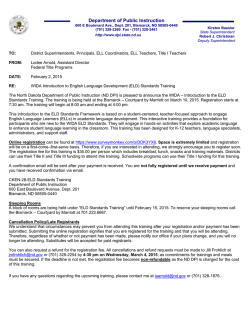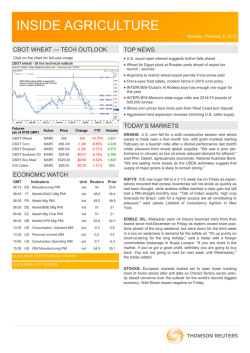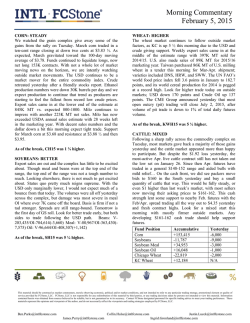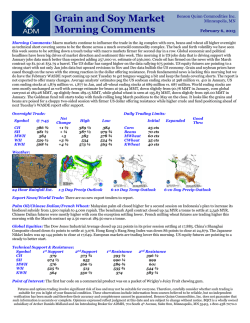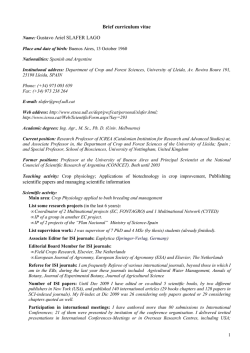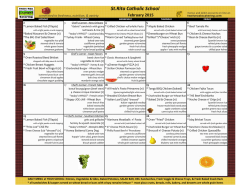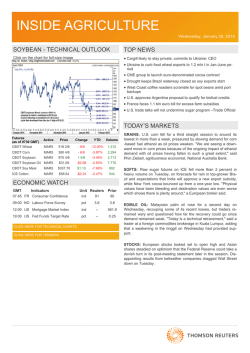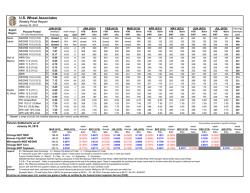
Spatial variation in non-target effects of the
Pesticide Science Pestic Sci 55:875±886 (1999) Spatial variation in non-target effects of the insecticides chlorpyrifos, cypermethrin and pirimicarb on Collembola in winter wheat Geoffrey K Frampton* Biodiversity and Ecology Division, School of Biological Sciences, University of Southampton, Bassett Crescent East, Southampton, SO16 7PX, UK Abstract: Contiguous winter wheat ®elds of similar cropping history and soil type were used in a study of the responses of Collembola to summer sprays of cypermethrin and pirimicarb in southern England. Chlorpyrifos was included in the study as a toxic standard. Epigeic arthropods were captured by suction sampling and crop-inhabiting species obtained by dissecting wheat ears. Eight genera of Collembola responded signi®cantly to the insecticide treatments. Collembolan abundance decreased after chlorpyrifos was applied but increased after use of cypermethrin. Negative effects of cypermethrin and pirimicarb on Collembola were not detected in this study. Effects of chlorpyrifos varied spatially as a result of faunal heterogeneity among the ®elds, despite apparent homogeneity of the site. Some species known to be susceptible to chlorpyrifos were absent from one or more of the ®elds. The implications of these ®ndings for the interpretation of non-target pesticide effects and the potential use of Collembola as bioindicators in ®eld studies with pesticides are discussed. # 1999 Society of Chemical Industry Keywords: insecticides; chlorpyrifos; cypermethrin; pirimicarb; Collembola; side-effects; bioindicators 1 INTRODUCTION Collembola (springtails) are among the most abundant of the non-target arthropods to be found in temperate arable farmland,1 where they are preyed upon both by stenophagous2,3 and polyphagous predatory arthropods.4 At certain times of the year Collembola may provide a large proportion of the diet of some species of Araneae (spiders) and Coleoptera (beetles)5±8 including species ranked as potentially important predators of cereal pests in Europe.9,10 The occurrence of Collembola in arable ®elds early in the season could be signi®cant in sustaining such predator populations and enhancing subsequent control of pests.11 However, the ecology of many species is relatively poorly understood despite their abundance and widespread distribution,12 a situation which appears to be typical of most farmland arthropods not deemed to be of immediate economic signi®cance.13 With the possible exception of the lucerne¯ea Sminthurus viridis L, which occasionally reaches pest status locally in southern Europe,14 or edaphic Onychiuridae in sugar beet,15 European Collembola appear overall to be bene®cial on account of their importance as prey and participation in nutrient cycling.16 Numerous ®eld studies have investigated the responses of predatory arthropods to the carbamate aphicide pirimicarb17±25 and to synthetic pyrethroid insecticides such as cypermethrin,17,20,23,26±31 deltamethrin,21,22,28,29,32±36 fenvalerate37±40 and lambdacyhalothrin.30,39,41,42 Cypermethrin is currently the most widely used insecticide in arable crops in Britain, and in 1996 was applied to 54% of the arable area grown (60% of the area of wheat), whilst pirimicarb was applied to 6% of the arable area.43 Despite the widespread use of these insecticides and extensive studies of their effects on predators, very little is known about effects of these insecticides on Collembola in arable ®elds.44 Semi-®eld methods such as mesocosms45 or bioassays46 have been used to investigate effects of pesticides on Collembola, but these approaches have so far involved a relatively small number of species. To date, no studies have been designed speci®cally to investigate effects of pirimicarb or cypermethrin on ®eld-resident assemblages of Collembola in arable crops. Some observations on effects of these insecticides have been made during studies which focused on other non-target arthropod groups, but results have largely been equivocal, either because Collembola were not the taxon of primary interest,23,27 their responses to pesticides were not presented in detail,47 or because effects of individual insecticides were confounded with other variables.48 Use of cyperme- * Correspondence to: GK Frampton, Biodiversity and Ecology Division, School of Biological Sciences, University of Southampton, Bassett Crescent East, Southampton, SO16 7PX, UK (Received 2 December 1998; revised version received 14 May 1999; accepted 3 June 1999) # 1999 Society of Chemical Industry. Pestic Sci 0031±613X/99/$17.50 875 GK Frampton Figure 1. Layout of unsprayed (U), chlorpyrifos (Ch), cypermethrin (Cy) and pirimicarb (P) treatments in four contiguous fields of winter wheat. Property a Field 1 Field 2 Field 3 Field 4 pH Organic matter (%) Coarse sand (%) Fine sand (%) Silt (%) Clay (%) Saturation capacity (%) P (mg litreÀ1) K (mg litreÀ1) Mg (mg litreÀ1) 6.9 8.8 26.9 34.4 15.9 15.5 88.9 70 272 101 6.5 6.8 21.9 38.0 21.0 12.8 76.4 31 216 107 6.5 6.2 33.3 31.5 15.6 9.8 78.5 23 102 48 6.3 4.4 34.7 29.1 16.1 11.7 77.4 31 192 107 a Table 1. Soil characteristics, October 1994 Soil analysis: estimates of mean organic matter contents (loss-on-ignition), particle composition (Bouyoucos hydrometer) and saturation capacity followed the methods given by Allen.52 pH and nutrient status were obtained from farm records. thrin in forestry was found to increase pitfall trap catches of Collembola after some sprays, possibly because predatory Carabidae, Staphylinidae and Linyphiidae were negatively affected.31 Studies with other synthetic pyrethroids have shown mixed effects on Collembola: in barley, fenvalerate, but not permethrin, decreased pitfall catches of Collembola in small (10 m  10 m) plots,40 whilst in pine litter Collembola numbers were unaffected by permethrin applied at a rate higher than that recommended for agricultural use.49 Effects of lambda-cyhalothrin on Collembola varied spatially in hops, with increased catches after spraying in one hop garden but decreased catches in another.42 Attempts to control Sminthurus viridis in lucerne in Australia showed that fenvalerate was ineffective50 whilst in eastern Spain catches of this species increased on some occasions after spraying with lambda-cyhalothrin.14 Pitfall catches of Collembola in a sugar beet crop in England were unaffected by a granular application of te¯uthrin.51 Relatively few data exist on inter-speci®c variation in responses of Collembola to synthetic pyrethroids and pirimicarb46 and in only one of the ®eld studies mentioned above42 were responses of individual species considered. The present study was carried out in 1994 to investigate effects on Collembola of chlorpyrifos, cypermethrin and pirimicarb in winter wheat. This 876 paper presents responses of ®eld-inhabiting species to summer applications of these insecticides in four contiguous ®elds. The ®ndings of this work are compared with those of a previously published study46 which used in-situ ®eld bioassays in one of the study ®elds to expose selected collembolan test species to residues of the insecticides. 2 MATERIALS AND METHODS 2.1 Experimental site The experimental site was located at Mereworth (TQ 660535) in south-east England (51 ° 16' N, 0 ° 23' E) and comprised four contiguous ®elds under winter wheat (Triticum aestivum L cv Hereward, drilled 14 October 1993) (Fig 1). These ®elds were chosen for the study because they had similar soil properties (sandy clay loam: Table 1) and had been farmed previously as a single unit, having received similar cropping (and pesticide and fertiliser inputs) for at least six years prior to the study (Table 2). The ®elds were mostly enclosed by, and shared, hedgerows of similar age dominated by hawthorn (Crataegus monogyna Jacq). Fertilisers and agrochemical applications other than the trial insecticides (Table 3) were applied to all study ®elds together as deemed necessary by the farm manager. Pestic Sci 55:875±886 (1999) Effects of insecticides on Collembola in winter wheat 5 km hÀ1, initially variable in direction then SE during the application of chlorpyrifos. Dry conditions persisted until heavy rainfall (at times exceeding 32 mm hÀ1) commenced c30 h after the last chlorpyrifos application had been made; the nearest rainfall reading (obtained c6 km from the study site) indicated that 49 mm had fallen between 30 and 33 h after the last insecticide applications. Table 2. Cropping in all study fields, 1987–1994 1993±94 1992±93 1991±92 1990±91 1989±90 1988±89 1987±88 Winter wheat cv Hereward Field beans cv Striker Winter wheat cv Slepjner Linseed cv Antares Winter wheat cv Hereward Spring peas Winter cereal 2.5 Arthropod sampling 2.2 Experimental design Each of the ®elds (2.3±3.4 ha) was divided into four plots (mean area 0.7 ha), to which four insecticide treatments were randomly assigned (Fig 1). These were cypermethrin 100 g litreÀ1 EC (`Ambush C'1; Zeneca), pirimicarb 500 g kgÀ1 SG (`Aphox'1; Zeneca), chlorpyrifos 480 g litreÀ1 EC (`Spannit'1; PBI) and an unsprayed control. Chlorpyrifos is a chemical to which Collembola are particularly sensitive,53 and served as a toxic standard. The timing of applications of cypermethin and pirimicarb was agriculturally realistic: in winter wheat, cypermethrin and pirimicarb would be applied as aphicides in June, whilst chlorpyrifos may be used as a diptericide, with potential also for control of aphids.46 2.3 Insecticide spray applications The insecticides were applied in dry weather on 23 June 1994 between 0900 h and 1240 h BST using a Hardi LY 800 tractor-mounted 12-m boom sprayer with a 20-nozzle system of 110 ° ¯at fan (F110/1.59/3) nozzles. A volume rate of c200 litre haÀ1 was achieved with an operating pressure of 2.2 bar and forward speed of 6.9 km hÀ1. To reduce the risk of crosscontamination, insecticide applications were made in ascending order of their known spectrum of toxicity to predatory arthropods, viz pirimicarb (0900±0940 h), cypermethrin (1030±1110 h), chlorpyrifos (1200± 1240 h). An interval of c50 min was required between insecticides to permit thorough cleansing of the spray tank and transport of the chemical to the ®eld. The time taken to spray an individual plot was c8 min. 2.4 Weather conditions The local screen temperature increased from 20 °C during the application of pirimicarb to 22 °C during chlorpyrifos spraying. Wind speed was mostly 3 to Date Table 3. Agrochemical applications excluding the trial insecticides, 1993– 1994 Pestic Sci 55:875±886 (1999) Ground-dwelling (epigeic) arthropods were sampled using a `Ryobi' suction sampler similar to one described by Macleod et al.54 On each sampling occasion, ®ve samples, c10 m apart, were collected from the centre of each plot, using a central tractor wheeling in the plot as a reference. Each sample (total area 0.052 m2) comprised ®ve 10-s duration subsamples (each 104 cm2) obtained by randomly placing the sampler nozzle in the crop, between wheat plants, within 1.5 m on either side of the tractor wheeling. The pooled sub-samples were transferred in situ into vials containing c70% methyl alcohol within 2 h of sampling. Samples were collected only when the crop and ground were dry. On each sampling occasion the order in which ®elds were sampled was varied and sampling of all plots was completed within 3.5 h. Samples were subsequently examined under a binocular light microscope and all arthropods except Acari were removed by hand. Arthropods were identi®ed where possible, with the aid of a compound light microscope if necessary. Sampling was carried out on a total of 10 occasions but insuf®cient time was available for processing of all samples. Accordingly, only data from 35 days pre- and 10 days post-treatment are reported here. Collembola were found on maturing ears of wheat during July and August and wheat ears were collected from each plot on 15 August 1994 (immediately before harvest). The purpose was to determine (1) which species were present on the plants, and (2) whether occurrence on wheat ears differed between insecticide treatments. In the centre of each plot, ®ve groups of wheat ears were selected at random. In each group, 20 wheat ears were isolated by bending the surrounding plants away. The isolated plants were then enclosed quickly from above in a large polythene bag and bent at right-angles so as to prevent escape of Type 14 Oct 93 17 Mar 94 Seed dressing Herbicides 28 Apr 94 Growth regulator 27 May 94 Fungicide Fungicides Chemical Carboxin thiobendazole (fungicide, FS) Chlorotoluron (2100 g. AI. haÀ1; SC) Mecoprop-p (600 g. AI. haÀ1; SL) Chlormequat choline chloride imazaquin (736 56 1.6 g. AI. haÀ1; SL) Cyproconazole (40 g. AI. haÀ1; SL) Chlorothalonil cyproconazole (375 40 g. AI. haÀ1; SC) Flusilazole (100 g. AI./haÀ1; EC) Fenpropidin (187 g. AI. haÀ1; EC) 877 GK Frampton Table 4. ANOVA model for the factors I (four levels), F (four levels) and T (two levels), with five samples S' nested within I and F and cross-factored with T Source of variation I F IÂF T TÂI TÂF TÂIÂF within samples residual: S'(I  F) S'(I  F)T d f. Mean square F-ratio 3 3 9 1 3 3 9 a b c d e f g a/h b/h c/h d/i e/i f/i g/i 64 64 h i arthropods while the ears were excised from the stems using scissors. Groups of wheat ears were sealed in polythene bags and frozen within 2 h of collection. After thawing, wheat ears were dissected in c70% methyl alcohol under a binocular light microscope to permit removal by hand of any arthropods present. 2.6 Crop monitoring Crop growth stage55 was recorded for 10 randomlyselected plants per ®eld on several occasions during the summer. Densities of wheat stems were estimated using ®ve 50 cm  50 cm quadrats thrown randomly from the centre of each plot on 7 August. Distributions of weeds and percentage ground cover were recorded in each ®eld on 16 August. 2.7 Statistical analysis The null hypotheses that pre- to post-treatment changes (À35 days to 10 days) in Collembola abundance were independent of the insecticide treatments, and that effects of insecticide treatments were independent of the ®eld in which they were applied, were tested using a three-way analysis of variance (ANOVA) (Table 4). Insecticide treatment (I), ®eld (F) and time (T) were included as ®xed effects because the study did not comprise a random sample of wheat ®elds. The null hypotheses were tested, respectively, using F-ratios for T  I and T  I  F (Table 4). Where treatment effect was signi®cant (P ` 0.05), 95% con®dence intervals for speci®c T  I contrasts in the ANOVA model were used to infer signi®cant differences between individual insecticides and the unsprayed control. Arthropod counts x were found to exhibit a log-normal distribution and were transformed to log10 (x 1) prior to analysis. Normality of the data after transformation was con®rmed graphically using normal quantile plots and homogeneity of variances veri®ed using Cochran's C.56 The hypothesis that counts x of arthropods obtained from the ears of wheat on 15 August were independent of insecticide treatment and ®eld was tested by applying a two-way ANOVA to log10(x 1)-transformed counts obtained from ®ve samples (S') per plot 878 (each sample comprised 20 wheat ears). Insecticide (I) and ®eld (F) were included as ®xed effects in the model S'(I  F). The same ANOVA model was used to test the hypothesis that density of wheat stems did not differ between insecticide treatments or ®elds, using ®ve samples per plot. Density of stems was analysed separately, rather than included as a co-variable in the main analysis of treatment effects because density estimates were made nearly two months after the insecticide treatments were applied. Stem densities were distributed normally and were not transformed prior to analysis. Partial correlation coef®cients (in which effects either of ®eld or treatment were held constant)56 were calculated to test two hypotheses: (1) that numbers of Collembola on wheat ears at harvest were independent of densities on the ground on 3 July (the latest date for which suction sample data were available); (2) that counts of Collembola were independent of the abundance of Linyphiidae (the most numerous predators of Collembola recorded in the study). 3 RESULTS 3.1 Crop monitoring Crop development rates were similar in each of the four ®elds (Fig 2). The density of wheat stems in August was more variable, but not obviously related to the insecticide applications (Fig 3). Weeds were distributed patchily in all ®elds and within the areas sampled did not exceed 5% ground cover (1.0 m2 quadrats). The most abundant species were Avena fatua L (mainly in Field 3 cypermethrin plot), Fallopia convulvulus (L) A Loeve (mainly in Field 4 pirimicarb plot) and Urtica dioica L (mainly in Field 2). In all ®elds, estimated ground cover on 16 August was: wheat 85±90%; bare soil 5±15%; and weeds 0±5%. 3.2 Ground-dwelling Collembola Assuming that the Collembola captured by suction sampling originated primarily from the ground surface within the area of the sampler nozzle, total collembolan density on the ground in July varied in the unsprayed plots from c4900 mÀ2 in Field 1 to c19200 mÀ2 in Field 2 (Table 5). Densities of the most numerous individual species differed consider- Figure 2. Crop development (decimal growth stage55) in the study fields. Pestic Sci 55:875±886 (1999) Effects of insecticides on Collembola in winter wheat being Entomobrya multifasciata (Tullb) (Table 6). Although collembolan densities per plant were low, total Collembola density in the crop canopy may have exceeded 700 mÀ2 (Table 6). 3.4 Effects of insecticides on the ground-dwelling fauna Figure 3. Wheat stem density 0.25 mÀ2 quadrats on 15 August. Differences were not significant for treatment (F3,64 = 0.93, P ! 0.05) or field (F3,64 = 2.68, P ! 0.05). ably between ®elds and some taxa (Deuterosminthurus spp, Isotoma viridis, Sminthurinus spp) were not present in all ®elds (Table 5). 3.3 Collembola on wheat ears Ten individual species or genera of Collembola were found on the ears of wheat sampled on 15 August (harvest date), the most frequently occurring species The null hypothesis that pre- to post-treatment changes in collembolan abundance were independent of insecticide treatment was rejected for eight genera (Table 7). For Collembola, all changes under the chlorpyrifos treatment were negative relative to the unsprayed treatment, whereas under cypermethrin and pirimicarb treatments all changes were positive (Table 7). In six cases signi®cant (F9,64 b 5.00; P ` 0.001) interactions between treatment and ®eld (I  T  F) indicated that the effects of insecticides were not independent of the ®eld in which they were applied (Table 7). The most numerous predators of Collembola among the arthropods counted in the samples were Linyphiidae and Staphylinidae, with mean counts on 3 July of 6.6±16.6 per suction sample. Linyphiidae were Table 5. Mean Æ SD (n = 5) suction-sampled Collembola catch (0.052 mÀ2) in unsprayed plots (3 July) Field 1 Isotoma notabilis SchaÈffer Isotoma viridis Bourlet Isotomurus spp Entomobrya multifasciata (Tullb) Lepidocyrtus spp Pseudosinella decipiens Denis Orchesella villosa (Geoffroy) Heteromurus nitidus (Templeton) Total of sub-order Arthropleona Deuterosminthurus spp Sminthurinus aureus (Lubbock) Sminthurinus elegans (Fitch) Sphaeridia pumilis (Krausbauer) Total of sub-order Symphypleona Total Collembola Table 6. Occurrence of Collembola on ears of wheat immediately before harvest (15 August) Pestic Sci 55:875±886 (1999) 7.2 (Æ0.8) 0.6 (Æ0.9) 96.0 (Æ106.0) 16.2 (Æ4.5) 64.0 (Æ40.4) 12.2 (Æ6.4) 0.2 (Æ0.4) 13.2 (Æ6.7) 220.4 (Æ157.9) 0.4 (Æ0.5) 0 36.2 (Æ26.7) 0.2 (Æ0.4) 37.2 (Æ26.7) 257.6 (Æ183.7) Field 2 43.6 (Æ8.4) 79.0 (Æ26.2) 630.4 (Æ224.0) 10.4 (Æ5.8) 59.6 (Æ32.4) 0.2 (Æ0.4) 12.0 (Æ10.0) 11.6 (Æ10.0) 995.6 (Æ352.4) 0 0.4 (Æ0.5) 0 1.2 (Æ0.8) 6.4 (Æ5.2) 1002.0 (Æ354.2) Entomobrya multifasciata Isotomurus palustris Lepidocyrtus cyaneus L violaceus Arthropleona nymphs indet Sminthurinus spp Lepidocyrtus spp indet Isotoma notabilis Sphaeridia pumilis Symphypleona nymphs indet Heteromurus nitidus Sminthurus viridis Bourletiella hortensis Fitch Total Collembola a Field 3 Field 4 4.2 (Æ3.5) 0.8 (Æ1.1) 715.6 (Æ248.7) 50.8 (Æ20.4) 31.8 (Æ17.6) 2.8 (Æ2.4) 29.2 (Æ16.4) 9.4 (Æ10.1) 850.6 (Æ265.2) 4.6 (Æ2.5) 4.4 (Æ1.7) 0.2 (Æ0.4) 18.2 (Æ14.5) 28.2 (Æ13.9) 878.8 (Æ264.6) 31.6 (Æ19.3) 0 384.6 (Æ142.7) 10.8 (Æ3.1) 3.6 (Æ2.3) 1.4 (Æ2.6) 0.2 (Æ0.4) 1.6 (Æ2.6) 437.6 (Æ144.8) 0 10.0 (Æ3.8) 0 67.6 (Æ45.4) 78.0 (Æ48.8) 515.6 (Æ157.8) Total number (1600 ears) Mean number per ear 1067 225 133 48 13 4 4 4 4 3 3 1 1509 0.7 0.1 0.1 `0.1 `0.1 `0.1 `0.1 `0.1 `0.1 `0.1 `0.1 `0.1 0.9 Estimated a density mÀ2 534 113 67 24 6.5 2 2 2 2 1.5 1.5 `1 755 Based on wheat plant density of 800 mÀ2 (Fig 3). 879 GK Frampton Table 7. Pre-treatment to post-treatment changes in suction captures of Collembola and predators under three insecticide treatments relative to changes in unsprayed plots Direction of change relative to unsprayed control ab F3,64 (I  T) I notabilis Isotomurus spp. E multifasciata Lepidocyrtus spp P decipiens O villosa H nitidus Total Arthropleona S aureus S elegans Sp pumilis Total Sminthurididae Total Symphypleona Total Collembola Linyphiidae Staphylinidae a b c 25.64 (P ` 0.001) 93.03 (P ` 0.001) 164.0 (P ` 0.001) 54.58 (P ` 0.001) 3.55 (P ` 0.05) 44.27 (P ` 0.001) 4.07 (P = 0.01) 92.65 (P ` 0.001) 23.04 (P ` 0.001) 31.96 (P ` 0.001) 51.37 (P ` 0.001) 9.47 (P ` 0.001) 97.63 (P ` 0.001) 97.15 (P ` 0.001) 5.22 (P ` 0.01) 12.91 (P ` 0.001) Chlorpyrifos Cypermethrin Pirimicarb Decrease Decrease Decrease Decrease c ns Decrease c Decrease Decrease Decrease c ns Decrease c Decrease Decrease Decrease Decrease Decrease Increase ns Increase ns ns ns ns ns Increase ns Increase c Increase Increase ns Decrease ns ns ns ns ns ns ns ns ns ns Increase c ns Increase ns ns ns Decrease Signi®cant changes (P ` 0.05) based on 95% CI for speci®ed contrast with control. n s Effect not signi®cant (P ! 0.05). Signi®cant interaction with ®eld but effect consistent in three out of four ®elds. negatively affected by chlorpyrifos and cypermethrin whereas Staphylinidae were negatively affected by chlorpyrifos and pirimicarb (Fig 4; Table 7). Correlations between counts of total Linyphiidae and total Collembola in suction samples on 3 July were positive, irrespective of the levels of insecticide treatment included in the correlation analysis (all treatments: r80 = 0.24, P ` 0.05; unsprayed only: r20 = 0.47, P ` 0.05; unsprayed and cypermethrin only: r40 = 0.36, P ` 0.05). No signi®cant correlations between the total linyphiid catch and counts of individual collembolan species were detected. ifos mirrored an effect of this insecticide on the ground-dwelling cohort (Fig 5). For Isotomurus spp, however, insecticide effects on ground-dwelling (Table 7) and crop-climbing individuals (Table 8) were inconsistent. Two of the arthropod groups which were obtained from wheat ears exhibited signi®cant correlations between densities on the plants on 15 August and densities on the ground (suction sampling) on 3 July. Partial correlation coef®cients56 (ie controlling for effects of ®eld and insecticide) were positive for the collembolan E multifasciata (r12 = 0.77, P = 0.001) and the total Collembola (r12 = 0.64, P ` 0.05). 3.5 Effects of insecticides on crop-inhabiting arthropods Of 40 arthropod species or groups which were present on the crop at harvest, seven exhibited signi®cant differences in density between insecticide-treated and unsprayed plots (Table 8). These included pest species such as Sitodiplosis mosellana (GeÂhin) (Diptera: orange wheat blossom midge) and Hemiptera (which principally comprised aphids). Signi®cant ®eld-bytreatment interactions occurred for S mosellana (F9,64 = 2.5, P ` 0.05) and total Collembola (F9,64 = 5.6, P ` 0.001) but in all ®elds densities of these species under chlorpyrifos and cypermethrin treatments were consistently lower than those in unsprayed plots. With the exception of Hemiptera, the responses of non-collembolan arthropods to the insecticides were indicative overall of negative effects of chlorpyrifos and cypermethrin. Two groups of Collembola, Isotomurus spp and Entomobrya multifasciata, exhibited signi®cant effects of the insecticide treatments on their density on wheat ears (Table 8). For E multifasciata, the negative in¯uence of chlorpyr880 4 DISCUSSION 4.1 Effects of the insecticides The results of this work provide evidence for broadspectrum negative effects of chlorpyrifos on Collembola but not for negative effects of either cypermethrin or pirimicarb. The negative effects of chlorpyrifos are consistent with its known broad spectrum of activity against arthropods.53 Inclusion of chlorpyrifos in this work revealed differences between ®elds in collembolan responses (Fig 4), which resulted at least in part from ®eld-to-®eld variation in abundance (Table 5). It is important to consider variation in the density of vegetation as this may in¯uence arthropod activity and distribution, and also exposure to sprayed pesticides.46 In the present work the density of crop plants varied between the experimental plots and ®elds, but the differences were neither consistent in direction nor statistically signi®cant (Fig 3). Increases in the abundance of Collembola after use of synthetic pyrethroids have been reported in other Pestic Sci 55:875±886 (1999) Effects of insecticides on Collembola in winter wheat Figure 4. Pre-treatment (À35 days) to post-treatment (10 days) changes in suction captures of Collembola and predators following insecticide treatment in each of four adjacent fields. studies.14,31 A number of possible explanations exist for the relative increases in the abundance of some Collembola species after cypermethrin was applied in the present work. These could include sub-lethal effects on behaviour, or indirect effects resulting from altered interactions with competitors or predators. Negative effects (knockdown or mortality) of synthetic pyrethroid insecticides on potential predators of Pestic Sci 55:875±886 (1999) Collembola are well known,57 e.g on predacious Acari,40,58 Araneae28,32,35,36,38,40,41,59,60 and Carabidae.17,20,22,28,32,34 Acari were not counted in the present study and Carabidae (mostly Trechus quadristriatus Schrank) were rare in suction samples (0.6± 4.2 per sample in unsprayed plots), so effects of the cypermethrin application on these arthropods were not investigated. Effects of cypermethrin were negative 881 GK Frampton Table 8. Differences between insecticide-treated and unsprayed plots in the density of arthropods on wheat ears immediately before harvest Difference relative to unsprayed control a F3,64 (I) Isotomurus spp Entomobrya multifasciata All Collembola Thysanoptera Hemiptera Sitodiplosis mosellana larvae All Diptera larvae a Chlorpyrifos Cypermethrin Pirimicarb ns Lower Lower Lower ns Lower Lower ns ns ns Lower Higher Lower Lower Higher ns ns ns Higher ns ns 3.1 (P ` 0.05) 81.7 (P ` 0.001) 30.8 (P ` 0.001) 109.2 (P ` 0.001) 11.4 (P ` 0.001) 38.4 (P ` 0.001) 32.6 (P ` 0.001) Tukey HSD test (a = 0.05); n s denotes P ! 0.05 for the speci®ed contrast. on Linyphiidae and positive on Collembola, suggesting a possible in¯uence of insecticide use upon linyphiid predation of Collembola; other workers have suggested that use of synthetic pyrethroids may favour increased collembolan abundance through negative effects on predators.31 In the current work, however, correlations between the abundance of Collembola and Linyphiidae were positive, indicating that high collembolan abundance did not consistently occur in samples with low linyphiid density. Further work would be needed to test properly the hypothesis that positive effects of cypermethrin upon Collembola result from an indirect effect on predation. A positive effect of pirimicarb upon abundance of Collembola was only detected in two groups, viz Sminthurinus elegans and the family Sminthurididae (which excludes S elegans) (Fig 4; Table 7). A lack of negative effects of pirimicarb on Collembola is consistent with its selectivity as an aphicide,57 ie its relatively narrow spectrum of effects on non-target arthropods.17±19,23,25,39,61 negative effects of chlorpyrifos and cypermethrin on canopy-inhabiting arthropods persisted even though heavy rainfall had occurred within 32 h of the insecticide applications. Adverse effects on predatory arthropods, particularly of synthetic pyrethroid insecticides, are liable to be reduced substantially if rain falls soon after an application.35,59 4.3 Comparison with in-situ bioassays During the experiment, an additional method for assessing effects of the insecticides on Collembola, using in-situ ®eld bioassays, was tested in one of the four study ®elds.46 The technique involved the collection of insecticide residues from Field 2 and 4.2 Crop-inhabiting arthropods Species of Collembola which occur on wheat plants (Table 6) could be at risk of direct exposure to pesticide sprays and to residues present on the crop.46 In this study, the presence of arthropods on the wheat plants was quanti®ed only at harvest and so the times at which different species colonised the foliage are not known. A positive correlation between the density of E multifasciata on the crop in August and captures from the ground (suction samples) in July indicates that spatial distributions of crop-dwelling and groundinhabiting cohorts of the population were not independent of one another. Effects of chlorpyrifos in the crop canopy were similar to those observed on grounddwelling insects and clearly apparent nearly eight weeks after the insecticide application (Fig 5). Slow recovery of E multifasciata after use of chlorpyrifos62 would be expected if the species has an inherently low dispersal ability. However, eight weeks is a relatively short time in which to expect arthropod recovery from effects of a chlorpyrifos spray,63,64 lack of recovery within 0.8±1.1 years would not be unexpected given the toxicity and persistence of the chemical.53 The 882 Figure 5. Captures of Entomobrya multifasciata obtained from suction samples and wheat ears under three insecticide treatments applied on 23 June. Pestic Sci 55:875±886 (1999) Effects of insecticides on Collembola in winter wheat subsequent exposure of Collembola to the residues under standard laboratory conditions. The bioassay approach permitted species which were not present, or rare, in suction samples to be exposed to realistic insecticide residues. It also enabled effects of manipulating exposure and soil type to be investigated. Results of the bioassay work revealed toxicity of chlorpyrifos, but not of cypermethrin or pirimicarb, to Folsomia candida Willem, Isotoma viridis Bourlet Isotomurus palustris (Muller) and Sminthurus viridis L and thus complement the results obtained from sampling arthropods in the ®eld. However, a limitation of the ®eld bioassay approach was that it could not detect the increases in abundance of some Collembola species caused by cypermethrin or pirimicarb. Whether the bioassay method could be improved to include such positive effects of insecticides would depend on the causal mechanism of the effects, which at present is unknown. Despite these limitations, there are several advantages to using a bioassay approach46 and the conclusions obtained using in-situ bioassays, ie that cypermethrin and pirimicarb were not harmful to four species of Collembola, remain valid. 4.4 Design of the experiment Much emphasis has been placed on efforts to integrate realistic spatial scales of study with the need for statistical replication.23,36,65±67 As the area available for ®eld experiments is usually limited, e g by the size of ®elds, replication places a constraint on the size of experimental plots that can be accommodated. This is problematic because, among predatory species, the rate of recolonisation (and hence recovery) is related inversely to the plot size.68±70 Effects of pesticides on Collembola have been detected using particularly 2 m  3 m,71 or small plots (10 m  10 m,40 72 1 m  1 m ), suggesting that at least some (especially euedaphic) collembolan species may have relatively low dispersal ability. However, it has been established that the relationship between plot size and recovery rate of predators also affects predation pressure at different distances into a pesticide-treated area.70,73 For ecological realism therefore, the spatial scale of study should be appropriate not only for Collembola but also for their predators, some of which have relatively high rates of dispersal.74 Assuming that estimates of arthropod recovery rates after use of broad-spectrum insecticides for carabid beetles68 and linyphiid spiders69 are broadly applicable to the current work, recolonisation of predators over a distance of 24 m (the shortest distance between a sampling location and potential source of recolonists in the current work) would not have been expected within 10 days of treatment. problem in ecotoxicological studies, where results obtained from individual ®elds may be dif®cult to interpret if vulnerable species are absent from some ®elds (Table 6). Two collembolan taxa which were particularly heterogeneous in their distribution between ®elds, Isotoma viridis and Deuterosminthurus spp (Table 5), were entirely absent from samples collected from chlorpyrifos-treated plots on 3 July but too rare in three out of four ®elds to warrant inclusion in the analysis. 4.6 Implications for the use of indicator species None of the Collembola species studied was negatively affected by cypermethrin. In terms of the detection of negative effects of synthetic pyrethroid insecticides, other arthropods such as Linyphiidae35,75 would be more appropriate as bioindicators. Collembola are, however, clearly susceptible to organophosphorus insecticide use,44,62 possibly to a greater extent than predatory arthropods.53 A combination of Collembola and Linyphiidae could have potential value for the detection of negative insecticide effects in agricultural systems where both synthetic pyrethroids and organophosphates are used widely, as occurs in UK arable farming.43 The spatial variability of Collembola is an unwanted attribute when it comes to the selection of bioindicator species, but heterogeneous spatial and temporal distributions in arable land are also found among predatory arthropod species,76 including recommended bioindicator species such as the carabid beetle Pterostichus (=Poecilus) cupreus L.77,78 The use of `guilds' of species with similar ecological characteristics65 is one possible approach for dealing with the problem of spatial variability; the more species that such a `guild' contains, the greater likelihood that the guild will be represented in a study ®eld. Given the relative paucity of information on collembolan ecology in arable habitats it is dif®cult to assign species of Collembola to guilds a priori on the basis of ecological characteristics. However, species could instead be grouped according to their responses to pesticides, in which case a suitable guild for the detection of either negative effects of chlorpyrifos or positive effects of cypermethrin could include I notabilis and E multifasciata (Table 7). Ideally, proposals for the use of particular species as bioindicators should draw upon information from as many pesticide studies as possible. A previous attempt at identifying species of potential value as bioindicators of negative effects of pesticide use44 yielded a number of species which were not encountered during the present work, underlining the need for a multi-species approach with Collembola for detecting non-target pesticide effects. 4.5 Arthropod spatial variability The inclusion of several ®elds in the work was an advantage because it yielded information on ®eld-to®eld variation in faunal abundance and insecticide effects. Spatial heterogeneity of faunas is a particular Pestic Sci 55:875±886 (1999) 5 CONCLUSIONS Summer aphicide sprays of cypermethrin and pirimicarb in winter wheat were not harmful to any species of epigeic Collembola. Cypermethrin increased abun883 GK Frampton dance of several species relative to densities in unsprayed plots whereas most of the species captured were unaffected by pirimicarb. Results from this and other studies suggest that a stimulatory effect of synthetic pyrethroids on Collembola might be a general phenomenon but the causal mechanism is not at present known. The possibility that increased collembolan abundance was caused by negative effects of synthetic pyrethroids on predatory arthropods warrants further investigation because many predators of Collembola are also natural enemies of crop pests. Effects of chlorpyrifos were consistently negative and persisted at least until harvest. Despite apparent homogeneity of the site, some species apparently susceptible to chlorpyrifos were not present in all ®elds, endorsing the need for a multi-species approach to the use of Collembola as bioindicators of pesticide effects in ®eld studies. 13 14 15 16 17 18 19 ACKNOWLEDGEMENTS I thank Hugh Lowe and staff of Baron's Place Farm for kindly providing the experimental site, insecticides, manpower and machinery, Patrick Doncaster for helpful comments on the statistical analysis and Philip Gould for help with the measurement of soil properties. 20 21 22 REFERENCES 1 Petersen H and Luxton M, A comparative analysis of soil fauna populations and their role in decomposition processes. Oikos 39:286±388 (1982). 2 Bauer T, Predation by a carabid beetle specialized for catching Collembola. Pedobiologia 24:169±179 (1982). 3 Bauer T, Beetles which use a setal trap to hunt springtails: The hunting strategy and apparatus of Leistus (Coleoptera, Carabidae). Pedobiologia 28:275±287 (1985). 4 Hopkin SP, Biology of the Springtails, Oxford University Press, Oxford, 330 pp (1997). 5 Sunderland KD, The diet of some predatory arthropods in cereal crops. J Appl Ecol 12:507±515 (1975). 6 Sunderland KD, Fraser AM and Dixon AFG, Distribution of linyphiid spiders in relation to capture of prey in cereal ®elds. Pedobiologia 29:367±375 (1986). 7 Alderweireldt M, Prey selection and prey capture strategies of linyphiid spiders in high-input agricultural ®elds. Bull Brit Arachnological Soc 9:300±308 (1994). 8 Krooss S and Schaefer M, How predacious are predators? A study on Ocypus similis, a rove beetle of cereal ®elds. Ann Appl Biol 133:1±16 (1998). 9 Sunderland KD and Vickerman GP, Aphid feeding by some polyphagous predators in relation to aphid density in cereal ®elds. J Appl Ecol 17:389±396 (1980). 10 Sunderland KD, Crook NE, Stacey DL and Fuller BJ, A study of feeding by polyphagous predators on cereal aphids using ELISA and gut dissection. J Appl Ecol 24:907±933 (1987). 11 Sunderland KD, Axelsen JA, Dromph K, Freier B, Hemptinne JL, Holst NH, Mols PJM, Petersen MK, Powell W, Ruggle P, Triltsch H and Winder L, Pest control by a community of natural enemies, in Arthropod Natural Enemies in Arable Land III. Acta Jutlandica 72: 2, ed by Powell W, Aarhus University Press, Aarhus, Denmark. pp 271±326 (1997). 12 Rusek J, Biodiversity of Collembola and their functional role in 884 23 24 25 26 27 28 29 30 31 the ecosystem. Biodiversity and Conservation 7:1207±1219 (1998). Potts GR, The environmental and ecological importance of cereal ®elds, in The Ecology of Temperate Cereal Fields, ed by Firbank LG, Carter N, Darbyshire JF and Potts GR, Blackwell Scienti®c Publications, Oxford. pp 3±21 (1991). Gimeno F and Perdiguer A, ComparacioÂn de grupos quõÂmicos insecticidas contra las plagas que afectan a la produccioÂn de forraje de alfalfa (2.a parte). Boletin de Sanidad Vegetal Plagas 21:29±41 (1995). Gratwick M, Crop Pests in the UK, Chapman and Hall, London. 490 pp (1992). Petersen H, A review of collembolan ecology in ecosystem context. Acta Zool Fennica 195:111±118 (1994). Cole JFH and Wilkinson W, Selectivity of pirimicarb in cereal crops, Proc 1984 Brighton Crop Protection Conf ± Pests and Diseases, British Crop Protection Council, Farnham, Surrey UK. pp 311±316 (1984). DeClercq R and Pietraszko R, On the in¯uence of pesticides on Carabidae and Staphylinidae in winter wheat. Comportement et effects secondaires des pesticides dans le sol. Versailles, France. Les Colloques de l'INRA, no 31, 1984, INRA. 273±278 (1985). Powell W, Dean GJ and Bardner R, Effects of pirimicarb, dimethoate and benomyl on natural enemies of cereal aphids in winter wheat. Ann Appl Biol 106:235±242 (1985). Cole JFH, Everett CJ, Wilkinson W and Brown RA, Cereal arthropods and broad-spectrum insecticides, Proc 1986 Brighton Crop Protection Conf ± Pests and Diseases, British Crop Protection Council, Farnham, Surrey UK. pp 181±188 (1986). Vickerman GP, Coombes DS, Turner G, Mead-Briggs MA and Edwards J, The effects of pirimicarb, dimethoate and deltamethrin on Carabidae and Staphylinidae in winter wheat. Med Fac Landbouww Rijksuniv Gent 52:213±223 (1987). Vickerman GP, Coombes DS, Turner G, Mead-Briggs MA and Edwards J, The effects of pirimicarb, dimethoate and deltamethrin on non-target arthropods in winter wheat. Compte Rendu de la Conference Internationale sur les Ravageurs en Agriculture, Paris, 1±3 December 1987, pp 67±74. Smart LE, Stevenson JH and Walters JHH, Development of ®eld trial methodology to assess short-term effects of pesticides on bene®cial arthropods in arable crops. Crop Prot 8:169±180 (1989). Niehoff B and Poehling H-M, Population dynamics of aphids and syrphid larvae in winter wheat treated with different rates of pirimicarb. Agriculture Ecosystems and Environment 52:51±55 (1995). Moreby SJ, Sotherton NW and Jepson PC, The effects of pesticides on species of non-target Heteroptera inhabiting cereal ®elds in southern England. Pestic Sci 51:39±48 (1997). Shires SW, A comparison of the effects of cypermethrin, parathion-methyl and DDT on cereal aphids, predatory beetles, earthworms and litter decomposition in spring wheat. Crop Prot 4:177±193 (1985). Shires SW, Effects of aerial applications of cypermethrin and demeton-S-methyl on nontarget arthropods of wheat. Ecotoxicol Environ Safety 10:1±11 (1985). Purvis G, Carter N and Powell W, Observations on the effects of an autumn application of a pyrethroid insecticide on nontarget predatory species in winter cereals, in Integrated Crop Protection in Cereals, ed by Cavalloro R and Sunderland KD, A A Balkema, Rotterdam. pp 153±166 (1988). Al Hussein IA, LuÈbke M and Wetzel T, Zum Ein¯uû von Insektiziden auf die AktivitaÈtsdichte der LaufkaÈfer (Col, Carabidae) im Winterweizen. J Appl Entomol 112:499±504 (1991). Martin TJ, The ecobiological effects of arable cropping including the non-target effects of pesticides with special reference to methiocarb pellets (Draza1, Mesurol1) used for slug control. P¯anzenschutz-Nachrichten Bayer 46:49±102 (1993). Holopainen JK and Rikala R, Effects of three insecticides on the Pestic Sci 55:875±886 (1999) Effects of insecticides on Collembola in winter wheat 32 33 34 35 36 37 38 39 40 41 42 43 44 45 46 47 48 49 activity of non-target arthropods in nursery soil. Acta Zool Fennica 196:329±332 (1995). Basedow T, Rzehak H and Voû K, Studies on the effect of deltamethrin sprays on the numbers of epigeal predatory arthropods occurring in arable ®elds. Pestic Sci 16:325±331 (1985). Matcham EJ and Hawkes C, Field assessment of the effects of deltamethrin on polyphagous predators in winter wheat. Pestic Sci 16:317±320 (1985). Fischer L and Chambon JP, Faunistical inventory of cereal arthropods after ¯owering and incidence of insecticide treatments with deltamethrin, dimethoate and phosalone on the epigeal fauna. Med Fac Landbouww Rijksuniv Gent 52:201±211 (1987). Everts JW, Aukema B, Hengeveld R and Koeman JH, Sideeffects of pesticides on ground-dwelling predatory arthropods in arable ecosystems. Environ Pollution 59:203±205 (1989). Pullen AJ, Jepson PC and Sotherton NW, Terrestrial non-target invertebrates and the autumn application of synthetic pyrethroids: Experimental methodology and the trade-off between replication and plot size. Arch Environ Contam Toxicol, 23:246± 258 (1992). Chiverton PA, Pitfall-trap catches of the carabid beetle Pterostichus melanarius, in relation to gut contents and prey densities, in insecticide-treated and untreated spring barley. Ent Exp Appl 36:23±30 (1984). DeClercq R and Casteels H, On the in¯uence of some insecticides and fungicides on the epigeal arthropod fauna in winter wheat, in Integrated Crop Protection in Cereals, ed by Cavalloro R and Sunderland KD, AA Balkema, Rotterdam. pp 167±170 (1988). Heimbach U, Effects of some insecticides on aphids and bene®cial arthropods in winter wheat. International Organisation for Biological Control (IOBC) WPRS Bulletin, 14:131±139 (1991). Huusela-Veistola E, Kurppa S and Pihlava J-H. Effects of fenvalerate and permethrin on soil arthropods and on residues in and decomposition of barley straw. Agricultural Science in Finland 3:213±223 (1994). Brown, RA, White JS and Everett CJ, How does an autumn applied pyrethroid affect the terrestrial arthropod community?, in Field Methods for the Study of Environmental Effects of Pesticides, BCPC Monograph No 40, ed by Greaves MP, Smith BD and Greig-Smith PW, British Crop Protection Council. Farnham, UK. pp 137±145 (1988). Filser J and Nagel RF, Untersuchungen zur Vergleichbarkeit von Insektizideffekten auf Collembolen unter Labor- und Freilandbedingungen. Verhandlungen der Gesellschaft fuÈr OÈkologie 22:397±403 (1993). Thomas MR, Garthwaite DG and Banham AR, Pesticide usage survey report 141: Arable farm crops in Great Britain 1996, MAFF, York. 97 pp (1997). Frampton GK, Sampling to detect effects of pesticides on epigeal Collembola (springtails). Asp Appl Biol 37:121±130 (1994). Petersen H and Gjelstrup P, Development of a semi-®eld method for evaluation of laboratory tests as compared to ®eld conditions, in Effects of Pesticides on Meso- and Microfauna in Soil, ed by Lùkke H, Danish Environmental Protection Agency, Copenhagen. pp 67±142 (1995). Wiles JA and Frampton GK, A ®eld bioassay approach to assess the toxicity of insecticide residues on soil to Collembola. Pestic Sci 47:273±285 (1996). Cole JFH and Wilkinson W, The effects of autumn sprays of cypermethrin, dimethoate and pirimicarb on cereal arthropods. Pestic Sci 16:211±212 (1985). BuÈchs W, Ein¯uss verschiedener landwirtschaftlicher ProduktionsintensitaÈten auf die Abundanz von Arthropoden in ZuckerruÈbenfeldern. Verhandlungen der Gesellschaft fuÈr OÈkologie 20:1±12 (1991). Heungens A and van Daele E, Toxicity of insecticides and nematicides on soil mites and Collembola in pine litter Pestic Sci 55:875±886 (1999) 50 51 52 53 54 55 56 57 58 59 60 61 62 63 64 65 66 67 68 69 substrate. Med Fac Landbouww Rijksuniv Gent 44:379±393 (1979). Bishop AL, McKenzie HJ, Barchia IM and Spohr LJ, Ef®cacy of insecticides against the lucerne ¯ea, Sminthurus viridis (L) (Collembola: Sminthuridae), and other arthropods in lucerne. Aust J Entomol 37:40±48 (1998). Dewar AM, Thornhill WA and Read LA, The effects of te¯uthrin on bene®cial insects in sugar beet. Proc 1990 Crop Protection Conf ± Pests and Diseases, British Crop Protection Council, Farnham, Surrey, UK. pp 987±992 (1990). Allen SE, Chemical Analysis of Ecological Materials, 2nd edn, Blackwell Scienti®c Publications, London. 368 pp (1989). van Straalen NM and van Rijn JP, Ecotoxicological risk assessment of soil fauna recovery from pesticide application. Rev Environ Contam Toxicol 154:83±141 (1998). MacLeod A, Wratten SD and Harwood RWJ, The ef®ciency of a new lightweight suction sampler for sampling aphids and their predators in arable land. Ann Appl Biol 124:11±17 (1994). Tottman DR, The decimal code for the growth stages of cereals, with illustrations. Ann Appl Biol 110:441±454 (1987). Sokal RR and Rohlf FJ, Biometry, 3rd edn, WH Freeman & Co, New York. 887 pp (1985). Theiling KM and Croft BA, Pesticide side-effects on arthropod natural enemies: a database summary. Agriculture, Ecosystems and Environment 21:191±218 (1988). Croft BA and Whalon ME, Selective toxicity of pyrethroid insecticides to arthropod natural enemies and pests. Entomophaga 27:3±21 (1982). Everts JW, Aukema B, Mullie WC, van Gemerden A, Rottier A, van Katz R and van Gestel CAM, Exposure of the ground dwelling spider Oedothorax apicatus (Blackwall) (Erigonidae) to spray and residues of deltamethrin. Arch Environ Contam Toxicol 20:13±19 (1991). Jagers op Akkerhuis GAJM, Westerhof R, van Straalen NM and Koeman JH, Water balance, respiration and immobilisation in relation to deltamethrin poisoning and physical conditions in the epigeal spider Oedothorax apicatus. Pestic Sci 44:123±130 (1995). Unal G and Jepson PC, The toxicity of aphicide residues to bene®cial invertebrates in cereal crops. Ann Appl Biol. 118:493±502 (1991). Frampton GK, The potential of Collembola as indicators of pesticide usage: evidence and methods from the UK arable ecosystem. Pedobiologia 41:34±39 (1997). Rushton SP, Luff ML and Eyre MD, Effects of pasture improvement and management on the ground beetle and spider communities of upland grasslands. J Appl Ecol 26:489± 503 (1989). Asteraki E, Hanks CB and Clements RO, The impact of two insecticides on predatory ground beetles (Carabidae) in newlysown grass. Ann Appl Biol 120:25±39 (1992). Sotherton NW, Jepson PC and Pullen AJ, Criteria for the design, execution and analysis of terrestrial non-target invertebrate ®eld tests, in Field methods for the study of environmental effects of pesticides, BCPC Monograph No 40, ed Greaves MP, Smith BD and Greig-Smith PW, British Crop Protection Council, Farnham, UK. pp 183±199 (1988). Thacker JRM and Jepson PC, Pesticide risk assessment and nontarget invertebrates: integrating population depletion, population recovery and experimental design. Bull Environ Contam Toxicol 51:523±531 (1993). Jepson PC, Scale dependency in the ecological risks posed by pollutants: is there a role for ecological theory in risk assessment?, in Ecotoxicological Risk Assessment of Contaminants in Soil, ed by van Straalen NM and Lùkke H, Chapman and Hall, London. pp 175±189 (1997). Jepson PC and Thacker JRM, Analysis of the spatial component of pesticide side-effects on non-target invertebrate populations and its relevance to hazard analysis. Functional Ecology 4:349± 355 (1990). Thomas CFG, Hol EHA and Everts JW, Modelling the diffusion 885 GK Frampton 70 71 72 73 74 component of dispersal during recovery of a population of linyphiid spiders from exposure to an insecticide. Functional Ecology. 4:357±368 (1990). Duf®eld SJ and Aebischer NJ, The effect of spatial scale of treatment with dimethoate on invertebrate population recovery in winter wheat. J Appl Ecol 31:263±281 (1994). Joy VC and Chakravorty PP, Impact of insecticides on nontarget microarthropod fauna in agricultural soil. Ecotoxicol Environ Safety 22:8±16 (1991). Krogh PH, Pertubation of the soil microarthropod community with the pesticides benomyl and isofenphos. Pedobiologia 35:71±88 (1991). Duf®eld SJ, Jepson PC, Wratten SD and Sotherton NW, The spatial changes in invertebrate predation rate in winter wheat following treatment with dimethoate. Ent Exp Appl 78:9±17 (1996). Thacker JRM and Dixon J, Modelling the within-®eld recovery of carabid beetles following their suppression by exposure to an insecticide. Ann Zool Fennici 33:225±31 (1996). 886 75 Everts JW, Willemsen I, Stulp M, Simons L, Aukema B and Kammenga J, The toxic effect of deltamethrin on linyphiid and erigonid spiders in connection with ambient temperature, humidity and predation. Arch Environ Contam Toxicol 20:20± 24 (1991). 76 Frampton GK, Effects of pesticide regimes on invertebrates, in Reducing Pesticide Inputs on the Arable Farm. The SCARAB and TALISMAN studies, ed by Alford D, Young JEB and Ogilvy SE, MAFF (In press) (1999). 77 Barrett KL, Grandy NJ, Hassan S and Oomen P, Pesticide regulatory testing procedures with bene®cial arthropods: recommendations arising from the SETAC-ESCORT workshop. Proc 1994 Brughton. Crop Protection Conf ± Pests and Diseases, British Crop Protection Council, Farnham, Surrey UK. pp 661±668 (1994). 78 Luff ML, Provisional Atlas of the Ground Beetles (Coleoptera, Carabidae) of Britain, Biological Records Centre, Institute of Terrestrial Ecology, Monks Wood, Abbots Ripton, Huntingdon. 194 pp (1998). Pestic Sci 55:875±886 (1999)
© Copyright 2025
